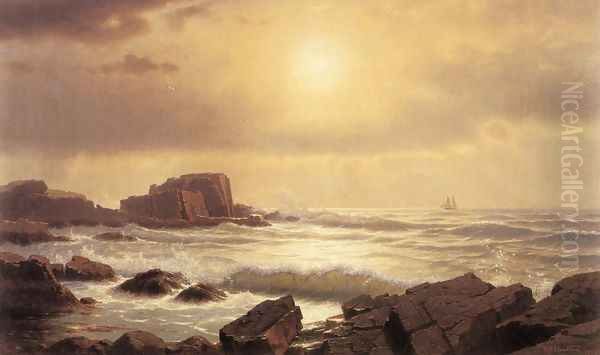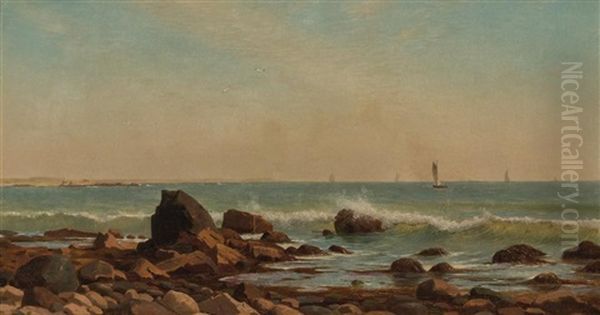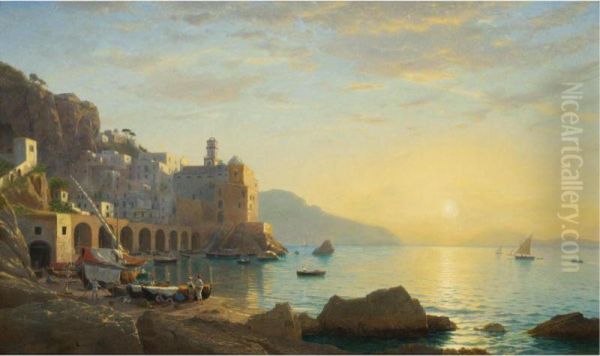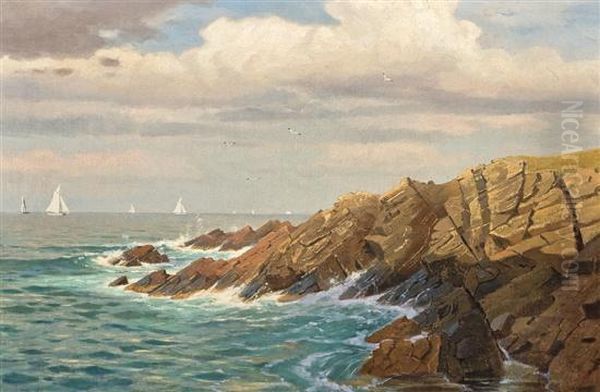
William Stanley Haseltine stands as a significant figure in nineteenth-century American art, a landscape painter whose career bridged the detailed realism fostered by German academic training with the atmospheric concerns of the Hudson River School and Luminism. Born into a well-to-do Philadelphia family in 1835, Haseltine developed a unique artistic vision characterized by meticulous geological accuracy, particularly in his depictions of coastal rock formations, alongside a profound sensitivity to light and atmosphere. His life and work reflect a transatlantic experience, moving between the artistic centers of the United States and Europe, ultimately creating a body of work celebrated for both its scientific precision and its poetic beauty.
Early Life and Artistic Inclinations
William Stanley Haseltine was born in Philadelphia, Pennsylvania, on June 11, 1835. His background provided a fertile ground for his future pursuits. His father, John Haseltine, was a successful businessman, ensuring a comfortable upbringing and access to education. Perhaps more crucially for his artistic development, his mother, Elizabeth Shinn Haseltine, was an amateur landscape painter. Her interest in art undoubtedly provided early encouragement and exposure for her son, nurturing his nascent talent and interest in depicting the natural world. This familial support set the stage for his formal education and artistic training.
Haseltine's academic journey began at the University of Pennsylvania, where he studied for two years. He then transferred to Harvard University, a prestigious institution that further broadened his intellectual horizons. He graduated from Harvard in 1854 with a Bachelor of Arts degree. While his university education provided a strong liberal arts foundation, his specific artistic training commenced shortly thereafter under the guidance of Paul Weber, a German immigrant artist residing in Philadelphia. Weber's instruction likely imparted elements of the precise, detailed approach characteristic of German landscape painting traditions.
European Training: Düsseldorf and Beyond

Seeking to deepen his artistic skills and immerse himself in the European art scene, Haseltine traveled abroad in 1856, shortly after his first exhibition appearance at the Pennsylvania Academy of the Fine Arts in 1855. His primary destination was Düsseldorf, Germany, a major center for art education that attracted numerous American painters in the mid-nineteenth century. At the Düsseldorf Academy, or at least within its influential circle, Haseltine honed his technical abilities, particularly in drawing and composition.
This period was crucial not only for training but also for the connections he forged. In Düsseldorf, he joined a vibrant community of American artists. He studied and associated with figures who would become prominent names in American art, including Emanuel Leutze, famous for his historical paintings like Washington Crossing the Delaware, the landscape painter Worthington Whittredge, and Albert Bierstadt, who would later gain renown for his dramatic depictions of the American West. He also encountered leading German artists like Andreas Achenbach, a master of seascapes known for his dynamic realism. These interactions and friendships proved enduring and influential throughout his career.
Following his time in Düsseldorf, Haseltine embarked on further travels, seeking inspiration directly from nature. He journeyed along the Rhine River, sketched in Switzerland, and eventually made his way to Italy. This exposure to diverse European landscapes, from the river valleys of Germany to the peaks of the Alps, broadened his visual vocabulary and artistic sensibilities.
First Italian Sojourn and Early Success
Italy, particularly Rome, captivated Haseltine. He settled in the Eternal City for several years around 1857-1858. The Italian landscape, steeped in history and bathed in a unique light, offered a stark contrast to the northern European scenes he had studied. He dedicated himself to painting the Roman Campagna, the surrounding countryside dotted with ancient ruins, and traveled to the scenic island of Capri in the Bay of Naples. His works from this period often depict these picturesque locations, capturing the interplay of classical ruins, rugged terrain, and the Mediterranean atmosphere. These early Italian landscapes helped establish his reputation as a skilled observer of nature and place.
Return to America: The Tenth Street Studio and Coastal Scenes

In 1858, Haseltine returned to the United States, initially to Philadelphia. Soon after, he moved to New York City and established a studio in the famed Tenth Street Studio Building. This building was the epicenter of the American art world at the time, housing the studios of many leading figures associated with the Hudson River School. Working alongside artists like Frederic Edwin Church, Albert Bierstadt (his Düsseldorf friend), Sanford Robinson Gifford, and John Frederick Kensett, Haseltine was positioned at the very heart of American landscape painting.
During this period, Haseltine turned his attention primarily to the landscapes of the northeastern United States, particularly the rugged coastlines of New England. He spent summers sketching at locations like Nahant, Massachusetts, Mount Desert Island in Maine, and Narragansett, Rhode Island. These excursions resulted in some of his most celebrated works. He developed a remarkable facility for rendering the complex geology of coastal rocks, capturing their textures, fissures, and formations with extraordinary precision. This meticulous approach earned his coastal scenes the moniker "rock portraits."
His focus on detailed geological accuracy aligned with the scientific interests of the era and the Hudson River School's emphasis on truthful depiction of nature, as championed by figures like Asher B. Durand. However, Haseltine combined this scientific observation with a subtle sensitivity to light and atmosphere, characteristics often associated with Luminism, a mid-century American style emphasizing tranquility, stillness, and ethereal light effects.
Masterworks of the American Coast
Several paintings from the early 1860s exemplify Haseltine's mastery of the American coastal scene. Rocks at Nahant (1864) is a prime example of his "rock portraits," focusing intensely on the geological structure and texture of the shoreline formations. The painting showcases his sharp draftsmanship and his ability to convey the solidity and ancient character of the rocks under specific light conditions.
Perhaps his most famous work from this period is Narragansett Bay (1864). This painting is often considered one of his masterpieces. It depicts the rocky shoreline meeting the sea, capturing the dynamic interplay between the enduring stone and the moving water. The geological detail is precise, yet the overall composition possesses a powerful sense of place and atmosphere. It embodies the blend of scientific observation and artistic sensibility that defined his best American work. Another significant work, Mount Desert Island, Maine (c. 1860-61), fetched a high price at auction centuries later, attesting to the enduring appeal of these coastal views.
Recognition and Academic Standing

Haseltine's growing reputation was reflected in his acceptance into the leading artistic institution of the time. He was elected an Associate Member of the National Academy of Design in New York in 1860. Just a year later, in 1861, he achieved the status of a full Academician (NA). This recognition solidified his standing among the foremost American painters of his generation. His works were regularly featured in exhibitions in major cities like New York, Boston, and Philadelphia, garnering critical attention and patronage.
Personal Life, Loss, and Return to Europe
Haseltine's personal life saw significant changes during the mid-1860s. He married Helen Marshall in 1860. Tragically, she died in 1864, the same year he produced some of his most notable coastal paintings. This loss may have contributed to his decision to eventually relocate. In 1866, he married Helen Lane, with whom he would have several children, including Herbert Haseltine, who later became a noted sculptor of animal subjects.
Shortly after his second marriage in 1866, Haseltine decided to move his family abroad. They initially settled in Paris, a global hub of art and culture. While Paris served as a base, his artistic heart seemed to remain drawn to Italy. After a few years, the family relocated again, this time making Rome their primary residence for much of the remainder of his life.
An Expatriate Life in Rome
From the late 1860s onwards, Haseltine lived primarily as an expatriate, based mainly in Rome. He established a prominent studio in the Palazzo Altieri, which became a well-known stop for American and European tourists and fellow artists visiting the city. His Roman base allowed him easy access to the Italian landscapes that continued to inspire him. He revisited familiar locations like Capri and the Roman Campagna, but also explored new areas, including Sicily, known for its dramatic coastline and ancient Greek ruins, and Venice, with its unique interplay of water, architecture, and light.
His Italian works from this later period often retain his characteristic precision but sometimes display a broader handling or a heightened sense of atmospheric effect, perhaps influenced by ongoing developments in European painting. Works like Baths of Trajan (1864, likely based on earlier sketches or a return visit) showcase his continued interest in depicting Italy's monumental classical past. Other paintings, such as The Bay of Naples, demonstrate his ability to evoke the specific light and atmosphere of southern Italy, sometimes drawing inspiration from classical literature, such as the landscapes described by Virgil, adding another layer of historical resonance to his views.
Later Travels and Final Years

Although Rome was his main residence, Haseltine remained an inveterate traveler. He continued to make sketching trips throughout Europe, visiting and painting in France, Belgium, and the Netherlands. He also maintained ties with the United States, making regular trips back across the Atlantic to visit family, handle business affairs, and perhaps reconnect with the American art scene.
His final trip to the United States occurred in 1899. Significantly, this journey included travel through several Western states. While less known for depicting the American West compared to his friend Albert Bierstadt, this late exposure to a different kind of American landscape suggests his enduring curiosity about the natural world.
William Stanley Haseltine's productive life came to an end in the city he had long called home. He died of pneumonia in Rome on February 3, 1900. He was buried in the Cimitero Acattolico (Non-Catholic Cemetery) in Rome, a historic burial ground that is the final resting place for many foreign artists, writers, and intellectuals who lived and worked in the city.
Artistic Style: Precision, Light, and Geology
Haseltine's artistic style is defined by a unique synthesis of objective observation and subjective interpretation. His training, particularly the influence of Düsseldorf and potentially Paul Weber, instilled in him a commitment to meticulous detail and accurate rendering. This is most evident in his treatment of geological formations. His rocks are not generic stage props but specific, identifiable structures rendered with an understanding of their composition and weathering. This scientific accuracy lent his work a sense of solidity and truthfulness that appealed to nineteenth-century audiences interested in the natural sciences.
However, Haseltine was more than just a geological draftsman. He possessed a remarkable sensitivity to light and atmosphere. His American coastal scenes often exhibit the clear, cool light and tranquil mood associated with Luminism. He masterfully captured the reflective qualities of water, the subtle gradations of the sky, and the way light defines form. In his European works, particularly those of Italy, he often employed a warmer palette and explored more dramatic light effects, capturing the haze of the Campagna or the brilliant sunshine of Sicily and Capri. He sometimes used contrasts, like vivid blues against oranges, to enhance the visual impact and emotional resonance of his scenes.

His technical skill extended beyond oil painting. Haseltine was also a proficient draftsman and watercolorist. His numerous drawings and sketches, often made on-site, formed the foundation for his finished oils and reveal his keen eye for detail and composition. His watercolors demonstrate a fluid handling of the medium and a nuanced understanding of light and color, often possessing a freshness and spontaneity that complements his more finished studio works.
Contemporaries and Artistic Circle
Throughout his career, Haseltine moved within significant artistic circles on both sides of the Atlantic. His formative years in Düsseldorf connected him with Emanuel Leutze, Albert Bierstadt, and Worthington Whittredge, as well as the German master Andreas Achenbach. These early associations were crucial in shaping his outlook and establishing lifelong professional friendships.
Upon his return to the US, his presence in the Tenth Street Studio Building placed him alongside the leading lights of the Hudson River School, including Frederic Edwin Church, Sanford Robinson Gifford, and John Frederick Kensett. He shared their dedication to landscape painting, although his specific focus on coastal geology and his European experiences gave his work a distinct flavor. His detailed approach to nature echoes the philosophy of Asher B. Durand, a key figure of the earlier Hudson River School generation. While primarily a landscape artist, his circle included figures known for other genres, like Leutze (history painting) and later his own son, Herbert Haseltine (animal sculpture). Other contemporaries whose work shared some affinities, particularly in detailed landscape or Luminist effects, include Martin Johnson Heade and Fitz Henry Lane, although direct collaboration or close association is less documented. His teacher, Paul Weber, also remains a key early influence. This network of colleagues and influences underscores his position within the mainstream of nineteenth-century American and transatlantic art.
Legacy, Collections, and Market Recognition
William Stanley Haseltine left a significant legacy as a master of landscape painting, particularly renowned for his ability to fuse scientific accuracy with poetic sensibility. He is considered an important figure associated with both the later Hudson River School and American Luminism. His meticulous depictions of coastal geology remain unique in American art of the period, valued not only for their aesthetic qualities but also for their documentary precision.
His work is held in the collections of major art museums across the United States, confirming his enduring importance. Prominent institutions housing his paintings include the Metropolitan Museum of Art in New York, the National Gallery of Art in Washington, D.C., the Museum of Fine Arts, Boston, the Whitney Museum of American Art, the Philadelphia Museum of Art, and the Brooklyn Museum, among others. His work has also been featured in significant exhibitions, including retrospectives that have reassessed his contribution to American art history, such as one organized by the Fine Arts Museums of San Francisco.
The high regard for Haseltine's work is also reflected in the art market. His paintings, particularly prime examples of his New England coastal scenes or luminous Italian views, command strong prices at auction. The sale of his Mount Desert (1860-61) for nearly $750,000 at Sotheby's, well above its estimate, and reports of other works selling for over $700,000, demonstrate the continued demand for his art among collectors. His appeal extended beyond American shores during his lifetime, attracting British and German collectors, and his international reputation persists today.
Conclusion: A Transatlantic Vision
William Stanley Haseltine carved a distinct path through the landscape of nineteenth-century art. He was an artist deeply engaged with the natural world, applying an almost scientific rigor to his observations, especially of the geological forces that shape coastlines. Yet, he infused these precise renderings with a profound feeling for light, atmosphere, and the spirit of place, whether capturing the cool clarity of the New England shore or the warm, history-laden air of Italy. As a figure who moved comfortably between America and Europe, he absorbed and synthesized different artistic traditions, creating a body of work that speaks to both the specific character of the locations he depicted and the universal appeal of landscape art. His paintings remain compelling testaments to a vision that embraced both objective truth and poetic beauty.